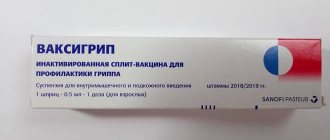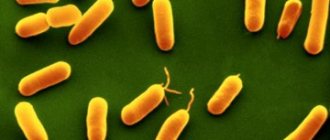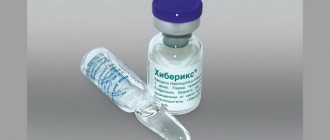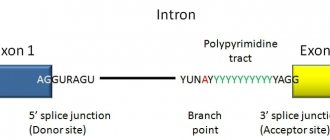Release form and composition
Dosage form - suspension for intramuscular and subcutaneous administration: transparent colorless liquid (0.5 ml in disposable syringes (with a needle) with a capacity of 1 ml, 1 syringe in cardboard holders, 1 holder in a cardboard pack).
In 1 dose of the Influvac vaccine (0.5 ml) there is 15 mcg of HA (hemagglutinin) of the following viral strains:
- A(H3N2)*;
- A(H1N1)*;
- B*.
* after the name of the type, the name of the strain recommended by the World Health Organization for the current epidemic influenza season is indicated.
Additional components: sodium phosphate dihydrate, potassium dihydrogen phosphate, sodium chloride, magnesium chloride hexahydrate, calcium chloride dihydrate, sodium citrate, potassium chloride, formaldehyde, sucrose, polysorbate 80, CTAB, water for injection.
Pharmacological properties of Influvac
Influvac, according to the instructions, is a third-generation subunit three-component vaccine. It is being developed specifically to combat the seasonal influenza virus.
With high immunogenicity, Influvac, due to the content of only surface antigens without foreign impurities and viral proteins, is characterized by low reactogenicity. It is for this reason that preventive vaccination against influenza can be given even to children from 6 months of age.
As mentioned above, to create the Influvac vaccine, new virus antigens are taken every year, or more precisely, hemagglutinin and neuraminidase. What specific viral strains are needed to create a medicine in the coming season are indicated in the recommendations of the World Health Organization. It is antigens that contribute to the production of specific antibodies to a specific strain of the virus. To ensure a specific immune response, two weeks are needed, during which the antibody titer increases, gradually reaching the required level.
According to medical reviews about Influvac, at least 95% of vaccinated people develop so-called post-vaccination specific immunity. In the future, if whole viral cells enter the body, the immune system “recognizes” them and absorbs B and T lymphocytes, thus stopping the growth and reproduction of the pathogen. Moreover, there is research evidence that human immunity works not only against influenza viruses, in almost half of the cases it also prevents the development of acute respiratory diseases. This is due to the fact that the antigenic structures of viruses that cause acute respiratory infections are similar to the influenza virus.
Post-vaccination immunity is not very durable; its duration is a maximum of 12 months.
Pharmacodynamics and pharmacokinetics
Influvac is an inactivated vaccine that contains purified surface antigens of influenza A and B virus strains. In accordance with WHO recommendations, the antigenic composition of the drug is updated annually. The vaccine has been approved by the Russian Ministry of Health as a means to prevent influenza.
With a single Influvac vaccination, the production of protective antibodies is observed in 95% of patients. Specific immunity, which appears after 14 days, lasts for a period of up to 1 year.
Adults have immunity to circulating viruses, so this category is vaccinated once. Children are vaccinated 2 times with an interval of 1 month. Influenza viruses are characterized by high variability, and the Influvac vaccine provides short-term protection, so all age categories should be vaccinated annually.
Pharmacokinetic data are not provided.
Reviews about Influvac
Vaccination is recognized by domestic and foreign researchers as the leading means of preventing influenza. First of all, because it significantly reduces the spread of infection and reduces the number of severe complications. This vaccine has been produced since 1950. The company constantly monitors its quality. Extensive application experience confirms the presence of a favorable safety profile. Clinical studies on this subject are conducted every year and serious adverse reactions are monitored and analyzed.
Every 5 years, the company publishes a review devoted to the experience of its use, and over all the years it has been concluded that the vaccine has weak reactogenicity and does not cause significant adverse reactions. It is subunit vaccines , being a modern generation, that have good immunogenicity and weak reactogenicity.
Influvac is characterized by fairly high rates of anti-epidemic and preventive protection. Even if vaccinated people get the flu, it is mild and without complications. All these points are reflected in the reviews.
- “... We do influvac for the flu with the whole family every year. There have never been any reactions, I think that the effect is obvious - everyone at work had the flu (some milder, some more severe) except me.”
- “... We make it for ourselves and our child every year. Everything is fine, no reactions.”
- “... We are getting vaccinated as a family. We don’t get the flu.”
- “... I’ve been vaccinating my daughter every year for 10 years now, and I’ve never had the flu. The youngest son was treated for 2 years in a row - there was no flu or severe ARVI either.”
- “... I did it for children, but I didn’t feel any difference - they still hurt.”
Indications for use
Influvac is used to prevent influenza in adults and children over 6 months of age. In particular, vaccination is recommended for the following categories of the population belonging to the risk group for influenza:
- Elderly people over 65 years of age;
- Children and adolescents aged 6 months to 18 years who have been receiving acetylsalicylic acid for a long time, as a result of which, under the influence of influenza infection, are at risk of developing Reye's syndrome;
- Patients with chronic renal failure;
- Patients with cardiovascular diseases of any etiology;
- People with respiratory diseases, including bronchial asthma;
- Patients with chronic metabolic disorders, incl. patients with diabetes mellitus;
- Patients with immunodeficiency diseases and patients receiving radiation therapy, cytostatics, corticosteroids or immunosuppressants in high doses.
Influvac
- hemagglutinin (HA) and neuraminidase (NA) of the following viral strains:
- A (H3N2) 15 µg
- GA A (H1N1) 15 mcg
- GA B 15 mcg GA
- Excipients:
- potassium chloride;
- potassium dihydrogen phosphate;
- sodium phosphate dihydrate;
- sodium chloride;
- calcium chloride dihydrate;
- magnesium chloride hexahydrate;
- water for injections
in disposable syringes complete with injection needles of 0.5 ml; in a cardboard pack 1 or 10 sets.
Description of the dosage form
Transparent colorless liquid.
Characteristic
Influenza vaccine, subunit, inactivated. Influvac® is a trivalent inactivated influenza vaccine consisting of surface antigens (GA, NA) of influenza viruses type A and B grown in chicken embryos. The antigenic composition of the influenza vaccine is updated annually according to WHO recommendations.
pharmachologic effect
Formative development of specific immunity.
Pharmacodynamics
Forms specific immunity to influenza viruses types A and B, which usually occurs 14 days after vaccination and lasts up to 1 year.
Indications for use Influvac
Prevention of influenza in adults and children from 6 months.
Vaccination is recommended for all individuals and, above all, for the following categories of the population who are at increased risk if influenza is combined with pre-existing diseases/conditions:
- persons over 65 years of age, regardless of their health status;
- patients with respiratory diseases;
- patients with cardiovascular diseases of any etiology;
- patients with chronic renal failure;
- patients with diabetes mellitus;
- patients with immunodeficiency diseases (HIV infection, malignant blood diseases, etc.) and patients receiving immunosuppressants, cytostatics, radiation therapy or high doses of corticosteroids;
- children and adolescents (from 6 months to 18 years) receiving medications containing acetylsalicylic acid for a long time and, therefore, at increased risk of developing Reye's syndrome due to influenza infection;
- pregnant women (II–III trimester). Pregnant women belonging to high-risk categories should be vaccinated regardless of the stage of pregnancy.
Influvac contraindications
- hypersensitivity to chicken protein or to any other component of the vaccine;
- severe fever or allergic reactions after previous vaccination with subunit influenza vaccines.
- Vaccination is postponed until the end of acute manifestations of the disease and exacerbation of chronic diseases. For mild ARVI, acute intestinal and other diseases, vaccination is carried out immediately after the temperature normalizes.
Use of Influvac during pregnancy and lactation
Experience with use shows that Influvac does not have a teratogenic or toxic effect on the fetus. The Influvac vaccine can be used during lactation.
Side effects of Influvac
From the circulatory and lymphatic system: rarely - thrombocytopenia.
From the immune system: rarely - allergic reactions are possible; very rarely - anaphylactic shock.
From the nervous system: often - headache; rarely - paresthesia, convulsions, encephalomyelitis, neuritis, Guillain-Barré syndrome.
However, convincing data on the connection of these reactions with vaccination have not been established.
From the vascular system: very rarely - vasculitis with transient renal dysfunction.
General disorders: often - fatigue and neuralgia, which do not require treatment and go away in 1-2 days.
Local reactions: redness, swelling, pain, induration, ecchymosis.
Systemic reactions: increased body temperature, malaise, trembling, sweating, soreness in muscles and joints.
In the room where vaccination is carried out, it is necessary to have drugs for the treatment of anaphylactic shock (adrenaline, glucocorticoids, etc.).
Drug interactions
Influvac can be used simultaneously with other vaccines (vaccines should be administered to different parts of the body with different syringes). Possible increased side effects.
If the patient is receiving immunosuppressive therapy, the immune response may be reduced.
After vaccination, it is possible to obtain false-positive results from serological tests (when performing an enzyme-linked immunosorbent assay (ELISA), which are caused by the production of IgM after vaccination.
Incompatibility: Cases of incompatibility are unknown.
Dosage
IM or s/c (deep). It is strictly forbidden to administer the drug intravenously. Immunization is carried out annually in the autumn. Adults and adolescents (from 14 years old) - 0.5 ml once, children: from 6 months to 3 years - 0.25 ml, from 3 to 14 years - 0.5 ml once; children who have not previously had influenza and have not been vaccinated, as well as patients with immunodeficiency - twice with an interval of 4 weeks.
Precautionary measures
The drug may contain undetectable residual amounts of gentamicin, so caution should be used when vaccinating individuals with hypersensitivity to aminoglycosides.
Bibliography:
- State Register of Medicines;
- Anatomical Therapeutic Chemical Classification (ATX);
- Nosological classification (ICD-10);
- Official instructions from the manufacturer.
Contraindications
- Hypersensitivity to vaccine components or chicken protein;
- Hypersensitivity reactions to substances that may be contained in residual quantities - gentamicin, CTAB, formaldehyde, polysorbate-80.
In case of acute diseases and exacerbation of chronic diseases, vaccination should be postponed until the condition improves.
For mild acute respiratory viral infections and acute intestinal diseases, immunization can be carried out immediately after body temperature normalizes.
Instructions for use of Influvac: method and dosage
The suspension is administered intramuscularly or deeply subcutaneously. The injection should be carried out carefully to avoid the drug entering the intravascular bed. It is strictly forbidden to administer the vaccine intravenously!
Immunization is carried out annually in the autumn.
Recommended doses:
- Adults and children over 3 years old – 0.5 ml once;
- Children from 6 months to 3 years – 0.25 ml once.
For previously unvaccinated children, the Influvac vaccine is recommended to be administered twice with a 4-week interval.
Rules for administering the vaccine:
- Warm the vaccine to room temperature;
- Shake the syringe immediately before injection;
- Remove the protective cap from the needle;
- Remove air from the syringe by holding it in a vertical position with the needle up and slowly pressing the plunger;
- Administer the vaccine intramuscularly or deeply subcutaneously. When administering a dose of 0.25 ml to children, the movement of the syringe piston should be stopped at the moment when its inner surface reaches the lower edge of the needle lock.
Analogues: comparison of which is better
The Influvac vaccine has analogues - interchangeable drugs that are similar in indications for use and belong to the same pharmacological group. If a specialist has recommended Influvac, then before using its analogue, you should consult a doctor about replacing the vaccine and carefully read the instructions for each drug. All influenza vaccines are inactivated and are divided into several types:
- subunit without adjuvant;
- subunit with adjuvant;
- split (split vaccines).
Subunit vaccines are immunogenic agents that contain only the surface proteins of the virus. Advantages of subunit vaccines: less likely to cause adverse reactions, less reactogenic.
An adjuvant is the name of a component that is used to enhance the immune response. The main property is to adsorb viral antigens on the surface and store them in the human body for up to 2 weeks. This allows you to achieve the desired immunogenicity, while reducing the antigenic load of the vaccine (the number of antigens) by 2 times. According to the developers, the effectiveness of vaccination does not decrease from this.
Subunit vaccines with adjuvant are produced only in Russia, and they do not formally comply with WHO recommendations. According to the latter, the influenza vaccine must contain 15 mcg of antigens of each type of virus. There are no imported vaccines with an adjuvant.
Split vaccines contain destroyed, inactivated virus virions. The vaccine contains virion proteins of the virus - surface and internal antigens.
Each flu medicine contains certain strains of influenza virus types A and B. The most effective analogues of the drug Influvac include:
- Ultrix;
- Vaxigrip;
- Sovigrip;
- Grippol and Grippol Plus;
- Flew M.
To understand which medicine is better, you need to compare analogues.
Ultrix
Ultrix is an inactivated split influenza vaccine of domestic origin. It is a light solution, available in ampoules. Available in two forms - 3-valent and 4-valent (that is, with antigens of 4 types of viruses). If you compare which is better Ultrix or Influvac, it is worth knowing that Ultrix can be produced with the addition of preservatives. This type is not recommended for children and nursing and pregnant women.
Vaxigrip
Vaxigrip is a vaccine produced by a French pharmaceutical company and is a split vaccine. Like Influvac, it contains 15 mcg of antigens of each strain, is approved for use from six months and is similar in composition and dosage. It is quite difficult to answer unequivocally whether Influvac or Vaxigrip is better. It is more convenient for children to use Vaxigripp, since it is available in a dose of 0.25 ml, which is advisable to use for vaccination of younger children (up to 3 years).
Sovigripp
Sovigripp is a domestically developed vaccine. Refers to the latest generation drugs. It is a subunit vaccine with an adjuvant. May be available with preservatives. Similar versions of the drug can be used by adults over 18 years of age. Regarding the drugs Influvac and Sovigripp, there is an opinion that the imported vaccine is better.
Grippol
Grippol is also a medicine produced by a domestic manufacturer. Refers to an inactivated subunit vaccine with an adjuvant. There are 2 versions: 3-valent and 4-valent. The latter applies only to those over 18 years of age. If you choose between the drugs Influvac and Grippol (4-valent), then adults are better off choosing Grippol, since it contains antigens of 2 types of influenza B virus.
Grippol Plus
The drug "Grippol Plus" is of domestic production. Can be used from 6 months. Quite effective, including for older people. Pregnancy and lactation are not contraindications. However, consultation with a doctor is required. Available in doses of 0.25 and 0.5 ml.
Flu-M
Flu-M is an anti-influenza inactivated split vaccine produced in Russia. Contains the amount of antigens recommended by WHO, without an adjuvant. One of the contraindications is age under 18 years. Let us remember that this type of vaccine often causes general and local reactions of the body to the administration of the drug. But they are still quite rare.
Side effects
Adverse reactions identified during clinical studies:
- Central nervous system: often – headache*;
- Musculoskeletal system: often – arthralgia*, myalgia;
- Local reactions: induration, pain, swelling and redness*, ecchymosis;
- Other: increased sweating*, increased body temperature, chills, malaise, fatigue.
* these reactions usually go away on their own within 1-2 days and do not require special treatment.
Side effects identified during post-marketing surveillance:
- Central and peripheral nervous system: paresthesia, neuralgia, neuritis, encephalomyelitis, convulsions, Guillain-Barré syndrome;
- Hematopoietic system: transient lymphadenopathy, transient thrombocytopenia;
- Cardiovascular system: vasculitis (in very rare cases may be accompanied by transient renal dysfunction);
- Dermatological and allergic reactions: generalized skin reactions, incl. itching, urticaria or nonspecific rash, manifestations of allergic reactions; in rare cases - anaphylactic shock, angioedema.
special instructions
The vaccination room should have all the supplies necessary for emergency treatment of anaphylactic shock, including glucocorticosteroids, adrenaline or epinephrine.
1 dose of the vaccine should not contain more than 1 mcg of ovalbumin.
The response to vaccination may be insufficient in patients with immunosuppression (both exogenous and endogenous).
In patients vaccinated with Influvac, it is possible to obtain false-positive results from serological tests performed by ELISA (enzyme-linked immunosorbent assay), such as the determination of antibodies against hepatitis C, HIV (HIV1), human T-cell lymphotropic virus (HTLV1). Laboratory diagnostics using Western blotting can eliminate false-positive results of these tests.
The drug does not have a negative effect on the speed of reactions and the ability to concentrate.
All cases of post-vaccination reactions must be reported to the attending physician.








